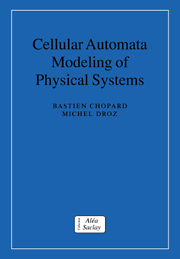5 - Reaction-diffusion processes
Published online by Cambridge University Press: 26 October 2009
Summary
Introduction
Systems in which different chemical species diffuse (for instance in a solvent or a gel) and then react together are quite common in science. Lattice gases provide a very natural framework to model such phenomena. In the previous chapter, we discussed how diffusion can be implemented as a synchronous random walk of many particles, using a velocity shuffling technique.
The model can be extended so that several different “chemical” species coexist simultaneously on the same lattice. It just requires more bits of information to store the extra automaton state. Then, it is easy to supplement the diffusion rule with the annihilation or creation of particles of a different kind, depending on the species present at each lattice site and a given reaction rule.
In agreement with the cellular automata approach, chemical reactions are treated in an abstract way, as a particle transformation phenomena rather than a real chemical interaction. Only the processes relevant at the macroscopic level are taken into account.
Systems in which reactive particles are brought into contact by a diffusion process and transform, often give rise to very complex behaviors. Pattern formation, is a typical example of such a behavior in reaction-diffusion processes.
In addition to a clear academic interest, reaction-diffusion phenomena are also quite important in technical sciences and still constitute numerical challenges. As an example, we may mention the famous problem of carbonation in concrete.
- Type
- Chapter
- Information
- Cellular Automata Modeling of Physical Systems , pp. 178 - 231Publisher: Cambridge University PressPrint publication year: 1998



